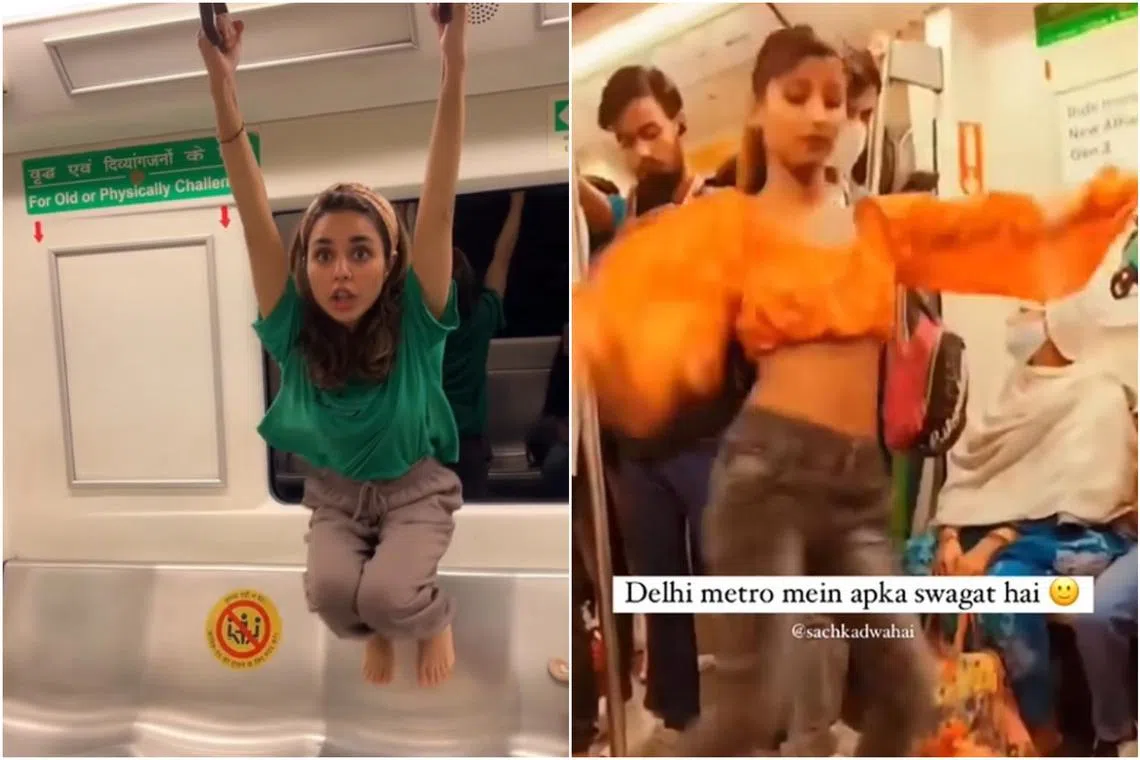India tries to get a handle on Instagram ‘Reels fever’
Sign up now: Get insights on Asia's fast-moving developments

Several recent videos on Instagram have ruffled the feathers of the Delhi Metro Rail Corporation.
PHOTOS: SCREENGRAB FROM APARNA_DEVYAL/INSTAGRAM, SACH KADWA HAI/FACEBOOK
Follow topic:
NEW DELHI - A woman in a short mustard-coloured top and grey jeans breaks into a dance in a crowded Mass Rapid Transit (MRT) coach. The Delhi Metro’s all-too-familiar welcome announcement, remixed and set to an electronic beat, forms the soundtrack for the video.
Two passengers film her, while others look on bemused. It is one of several recent videos that have ruffled the feathers of the Delhi Metro Rail Corporation (DMRC).
So much so that it put out a warning on Monday banning the filming of Instagram Reels or dance videos, as well as any other activity that may bother other passengers.
“Be a passenger, not an inconvenience,” read its tweet.
A similar warning was issued around five years ago but that failed to curb this trend, prompting the DMRC to reiterate its order, given “too many occurrences” of such videos, said DMRC spokesman Anuj Dayal.
“The metro is for a comfortable and normal commute... We don’t want our passengers inconvenienced by this sort of activity,” he told The Straits Times.
In another video that received more than 58,000 likes but also drew criticism, a young girl swings on the handrails and dances on seats in an empty section of an MRT coach. She even waves and blows a kiss at the closed circuit television (CCTV) camera.
The hunger for online popularity has kept the authorities elsewhere in the country busy too as Instagrammers and other social media users take to filming at some iconic locations, often posing a risk not just to themselves but also others.
In Ghaziabad, a city on the edge of Delhi, the police were forced to install 45 CCTV cameras recently along a 10.3km elevated section of an expressway after it became a coveted spot for video-makers in recent months because of the panoramic views it offers over the city.
Daredevil stunts on motorbikes and cars, dancing next to vehicles parked on the edge of the road and even birthday celebrations along the expressway – the list kept on growing.
Police say chances of collisions rise when other drivers stop their vehicles or slow down to watch such instances of filming.
The Times of India reported in January that the Ghaziabad police had arrested more than 40 people for making videos or holding celebrations on various roads, while fining over 95 offenders for making stunt reels in 2022.
Dr Janarthanan Balakrishnan, an assistant professor at the National Institute of Technology in Tiruchirappalli, told ST that such behaviour is motivated by the desire for greater viewership and likes online, including by filming at places that involve challenges or risks, so they can “prove themselves and show their confidence level”.
Other reasons could be peer pressure or the desire to mimic similar videos that may have been filmed at these locations.
“Basically, it boils down to narcissism and attention-seeking,” added Dr Balakrishnan, whose research interests include cyber psychology.
“People want that attention, and whenever there is a location that helps them achieve this goal, they definitely go for it.”
This “Reels fever” is widespread in India, where nearly half the population is under 25 and more than 750 million use smartphones.
India also has the world’s fifth-cheapest data prices – 1GB costs an average of just around 23 Singapore cents, pushing Indians to spend an average 60 minutes daily watching videos online.
At times, the production of these videos can have fatal results.
In March, a 31-year-old woman died in Pune after reportedly being hit by a motorcycle as its driver and pillion rider were busy making an Instagram video.
Taking selfies has also long been an extreme sport in India.
A 2018 study found that about half of the world’s 259 reported selfie deaths and accidents between 2011 and 2017 occurred in India. It is a blight that still continues.
A 27-year-old man was trampled to death on Tuesday by a wild elephant in Tamil Nadu’s Krishnagiri district as he attempted a selfie with the jumbo.
In one of the worst occurrences of selfie deaths, a lightning strike killed 16 people in July 2021 in Jaipur while they were taking selfies in the rain on top of a watchtower at the city’s iconic 12th century Amer Fort.
The authorities have marked out selfie points at certain popular locations to dissuade risky behaviour.
This was the case at Delhi’s Signature Bridge, a 675m-long cable-stayed construction. Soon after its opening in 2018, people climbed onto its suspension cables or dangled themselves out from moving cars to get that perfect selfie.
Other popular locations have opted for “no-selfie zones”.
In 2021, Dang, a district in Gujarat, banned selfies at some of its popular tourist locations, including Gira Waterfalls. It is an order that still stands despite criticism.


